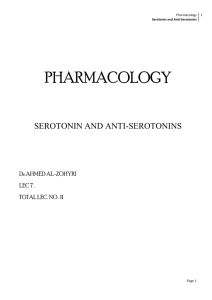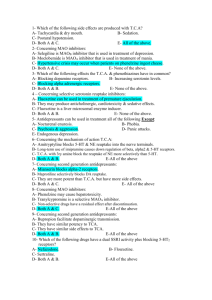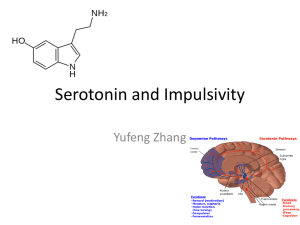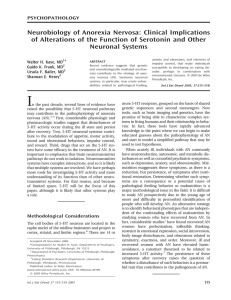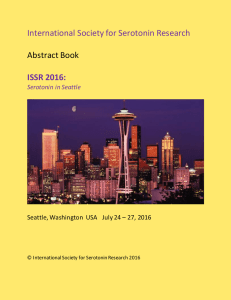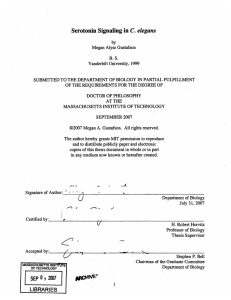Biology
advertisement
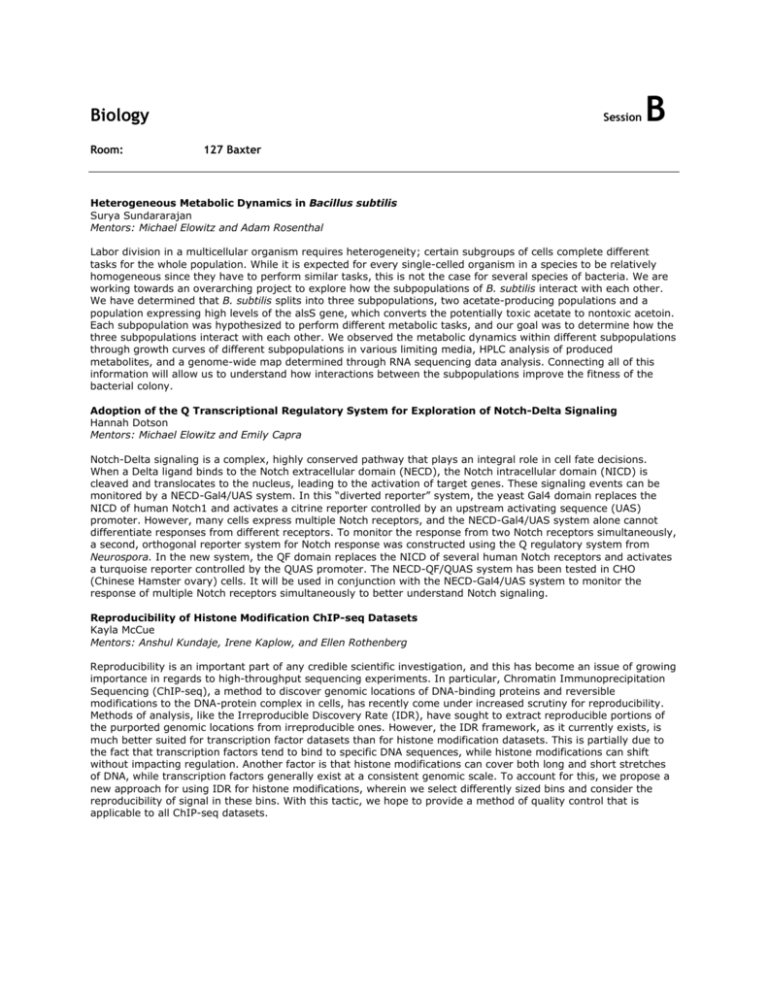
Biology Room: Session B 127 Baxter Heterogeneous Metabolic Dynamics in Bacillus subtilis Surya Sundararajan Mentors: Michael Elowitz and Adam Rosenthal Labor division in a multicellular organism requires heterogeneity; certain subgroups of cells complete different tasks for the whole population. While it is expected for every single-celled organism in a species to be relatively homogeneous since they have to perform similar tasks, this is not the case for several species of bacteria. We are working towards an overarching project to explore how the subpopulations of B. subtilis interact with each other. We have determined that B. subtilis splits into three subpopulations, two acetate-producing populations and a population expressing high levels of the alsS gene, which converts the potentially toxic acetate to nontoxic acetoin. Each subpopulation was hypothesized to perform different metabolic tasks, and our goal was to determine how the three subpopulations interact with each other. We observed the metabolic dynamics within different subpopulations through growth curves of different subpopulations in various limiting media, HPLC analysis of produced metabolites, and a genome-wide map determined through RNA sequencing data analysis. Connecting all of this information will allow us to understand how interactions between the subpopulations improve the fitness of the bacterial colony. Adoption of the Q Transcriptional Regulatory System for Exploration of Notch-Delta Signaling Hannah Dotson Mentors: Michael Elowitz and Emily Capra Notch-Delta signaling is a complex, highly conserved pathway that plays an integral role in cell fate decisions. When a Delta ligand binds to the Notch extracellular domain (NECD), the Notch intracellular domain (NICD) is cleaved and translocates to the nucleus, leading to the activation of target genes. These signaling events can be monitored by a NECD-Gal4/UAS system. In this “diverted reporter” system, the yeast Gal4 domain replaces the NICD of human Notch1 and activates a citrine reporter controlled by an upstream activating sequence (UAS) promoter. However, many cells express multiple Notch receptors, and the NECD-Gal4/UAS system alone cannot differentiate responses from different receptors. To monitor the response from two Notch receptors simultaneously, a second, orthogonal reporter system for Notch response was constructed using the Q regulatory system from Neurospora. In the new system, the QF domain replaces the NICD of several human Notch receptors and activates a turquoise reporter controlled by the QUAS promoter. The NECD-QF/QUAS system has been tested in CHO (Chinese Hamster ovary) cells. It will be used in conjunction with the NECD-Gal4/UAS system to monitor the response of multiple Notch receptors simultaneously to better understand Notch signaling. Reproducibility of Histone Modification ChIP-seq Datasets Kayla McCue Mentors: Anshul Kundaje, Irene Kaplow, and Ellen Rothenberg Reproducibility is an important part of any credible scientific investigation, and this has become an issue of growing importance in regards to high-throughput sequencing experiments. In particular, Chromatin Immunoprecipitation Sequencing (ChIP-seq), a method to discover genomic locations of DNA-binding proteins and reversible modifications to the DNA-protein complex in cells, has recently come under increased scrutiny for reproducibility. Methods of analysis, like the Irreproducible Discovery Rate (IDR), have sought to extract reproducible portions of the purported genomic locations from irreproducible ones. However, the IDR framework, as it currently exists, is much better suited for transcription factor datasets than for histone modification datasets. This is partially due to the fact that transcription factors tend to bind to specific DNA sequences, while histone modifications can shift without impacting regulation. Another factor is that histone modifications can cover both long and short stretches of DNA, while transcription factors generally exist at a consistent genomic scale. To account for this, we propose a new approach for using IDR for histone modifications, wherein we select differently sized bins and consider the reproducibility of signal in these bins. With this tactic, we hope to provide a method of quality control that is applicable to all ChIP-seq datasets. Genome-Wide Characterization of lncRNA-Protein Interactions Rushikesh Joshi Mentors: Mitchell Guttman and Mario Blanco It has become apparent that our genome is primarily comprised of non-coding RNAs (ncRNAs), and not protein coding messenger RNAs (mRNAs). Advances in high-throughput RNA sequencing have established the existence of thousands of large non-coding RNAs (lncRNAs). Experimental procedures have been developed to isolate lncRNAs, to explore their diverse biological and regulatory roles. As is true with classical ncRNAs, the function of lncRNAs depend on RNA-protein interactions. The prevailing hypothesis proposed by our group is that lncRNAs act as flexible, modular scaffolds, and are essential for assembling protein complexes based on highly specific, discrete, protein-binding domains within the lncRNA. By UV irradiating mouse embryonic stem cells we can crosslink in vivo RNA-protein interactions via the formation of a covalent RNA-protein adduct. We have been able to utilize computational methods to identify the discrete interaction domains with single-nucleotide resolution. To verify our results, we used previously determined high resolution three-dimensional structures of known RNA-protein complexes to compute RNA-protein inter-atomic distances; highlighting regions of close interaction. We next plan to create a genome-wide map of protein-binding sites across all lncRNAs. Once a map is established, we can begin isolating these discrete binding sites, to determine their regulatory roles in the genome. Utilizing Antibody-Oligo Coupling to Characterize Protein Complexes in lncRNAs Emily Mazo Mentors: Mitch Guttman and Amy Chow Characterizing protein complexes currently depends on time-and-resource-intensive methods such as mass spectroscopy; these methods are non-scalable and hold our ability to quickly discover the proteins that RNA molecules interact with, which helps us to determine their functions (and the methods by which they carry out such functions). Similarly, it is possible that some large non-coding RNA molecules can form several different protein complexes, which may carry out different functions; methods such as mass spectroscopy are incapable of identifying the protein complex at the single RNA molecule level, which is required for determining whether different complexes can be formed. By coupling DNA oligo tags to antibodies, we have created a proteinidentification assay that can quickly identify the proteins that interact with a given lncRNA. Utilizing the principle of combinatorial barcoding, we will in the future use this A-O assay to characterize, on the single-molecule level, the protein complexes of individual lncRNAs and quantify the frequency of protein complex permutations. Investigating Potential Interactions Between Gut Microbiota, Serotonin, and the Immune System Gauri Shastri Mentors: Elaine Hsiao and Jessica Yano Gut microbiota play an important role in producing neuroactive molecules. Our lab has shown that particular subsets of spore-forming bacteria normally present in the intestine are critical for promoting host serotonin biosynthesis. While little is known about this particular community of microbes, recent studies indicate that indigenous spore-forming bacteria elevate levels of immunosuppressive T regulatory cells in the mouse colonic lamina propria. In light of the increasing appreciation that serotonin modulates various aspects of innate and adaptive immunity, we asked whether the immunosuppressive and serotonergic functions of spore-forming bacteria are conferred through convergent mechanisms, or whether they occur through independent, parallel pathways. To determine whether serotonin is necessary for the ability of spore-forming bacteria to induce colonic T regulatory cells, we isolated lymphocytes from the colonic lamina propria of germ-free (GF) mice, conventionally-colonized (specific pathogen-free, SPF) mice, GF mice colonized with spore-forming bacteria, and GF mice colonized with spore-forming bacteria and intrarectally injected with parachlorophenylalanine (PCPA), an inhibitor of serotonin synthesis. Lymphocytes were stained with antibodies to identify T regulatory cells. The percentage of T regulatory cells from the colonic lamina propria was measured by flow cytometry. To determine whether serotonin is sufficient to induce colonic T regulatory cells in GF mice, we measured T regulatory cell levels in GF mice intrarectally injected with serotonin. Finally, we measured colonic T regulatory cells from mice harboring a genetic mutation in the serotonin transporter, SERT, which enables serotonin uptake by cells. Overall, our findings reveal a potential interaction between microbiota-mediated increases in serotonin biosynthesis and colonic T regulatory cells. Uncovering Microbial Metabolites That Promote Host Serotonin (5-HT) Biosynthesis Kristie Yu Mentors: Elaine Hsiao and Jessica Yano The gastrointestinal (GI) tract harbors a great abundance and diversity of microorganisms, collectively called the microbiota, that critically regulate host functions, including metabolism and activity of the nervous system. Over 90% of the body’s serotonin (5-HT) is produced by enterochromaffin cells, a specialized endocrine cell type located in the GI tract. 5-HT is a neurotransmitter involved in many regulatory processes, and disruption of 5-HT metabolism is linked to many disorders, such as depression and irritable bowel syndrome. Serum 5-HT levels in mice raised in the absence of microbial colonization (germ-free) are decreased by about 60%, as compared to serum 5-HT levels in conventionally-colonized (wildtype) mice, indicating that the microbiota regulates 5-HT metabolism. We demonstrate that metabolites from colonic luminal contents of mice colonized with a defined subset of microbes sufficiently promote 5-HT production in cultured chromaffin cells, suggesting that particular members of the microbiota produce biochemicals that modulate host 5-HT synthesis. To determine the identities of candidate serotonergic metabolites, we profiled small molecules present in colonic luminal contents of germ-free, conventionally-colonized, and gnotobiotic mice by LC/GC-MS-based metabolomics screening. Metabolites that significantly co-vary with 5-HT levels were identified, and tested for their ability to induce 5-HT production by cultured chromaffin cells. Metabolites that sufficiently increased 5-HT levels when applied at physiologically relevant concentrations in vitro were then tested in vivo for their ability to elevate 5-HT biosynthesis and abrogate 5-HT deficiencies in germ-free mice. Mice injected with particular microbially-modulated metabolites exhibit increased 5-HT concentrations in both colons and serum compared to controls, indicating that these metabolites can also affect 5-HT production in vivo. Overall, we demonstrate that specific metabolites modulated by limited bacterial species from the gut microbiota regulate host 5-HT levels, and further raise the interesting possibility of developing novel microbe-based treatments for serotonergic disorders. Developing Genetic Methods to Control Insect Populations Wen Min Chen Mentors: Bruce Hay and Omar Akbari Harmful insects, including agricultural pests and disease vectors, cause billions of dollars worth of crop losses and millions of deaths. Current solutions include applying insecticides, laying traps, and installing barriers to mitigate damage. However, for many insects there are no effective conventional methods to control pest populations. The release of genetically engineered insects carrying lethal genes provides a cheap and environmentally-friendly method to reduce insect numbers. There are two systems under development: a vanillic acid-repressible dominant lethal (VanDaL) system, and an X chromosome shredder system. The VanDaL system contains a lethal transgene that is not expressed when insect food is supplemented with vanillic acid, allowing efficient sex-separation of sterile insects. When these sterile insects are released into the wild, they interbreed with wild insects yet do not produce viable offspring, reducing the population. The X chromosome shredder system utilizes homing endonucleases to target DNA sequences unique to the X chromosome. Males expressing this construct would only generate sperm containing the Y chromosomes, greatly distorting the sex-ratio of the offspring. Eventually there would be no female insects left, leading to a population crash. The VanDaL system needs to be optimized for lethality, while constructs for the X-shredder system are being tested. Engineering Synthetic HEGs for Species Eradication Using CRISPR Albert Liu Mentors: Bruce Hay and Omar Akbari Some pest species such as Aedes aegypti are vectors for human disease, and also can be eliminated from the environment without incurring a significant ecological impact. Thus, complete removal of the pest species becomes a positive and desired outcome. Homing endonucleases (HEGs) are selfish genetic elements that cut and copy themselves into chromosomes they are absent from. Copying is achieved by taking advantage of the organism’s natural DNA repair machinery, and consequently HEGs are able to drive and fixate within populations. Using CRIPSR we were able to create synthetic HEGs that home into either yellow-g or VM genes in Drosophila melanogaster, both of which are theorized to be necessary for female fertility. As the HEG spreads throughout the population, all homozygous females should be sterile, eventually resulting in a population crash once all remaining females are sterile. So far we have results demonstrating ectopic homing of the constructs. Consequent experiments include confirmation of homozygous female sterility, quantification of the CRIPSR/Cas-9 mediated cutting/homing rates, and attempted population crash experiments. As CRISPR is universal across species, once a population crash in Drosophila melanogaster is confirmed, transferring the system to pest species of interest should pose little difficulty. Structure of Membrane-Bound Chemoreceptor Arrays in Archaea and Implications for Chemotactic Signaling Audrey Huang Mentors: Grant Jensen and Ariane Briegel Most motile bacteria sense and respond to their environment through a membrane-bound chemoreceptor array, the structure and function of which has been studied extensively. Most motile archaea possess a similar chemotactic signal transduction system involving chemoreceptor proteins homologous to those in bacteria, but its structure is largely unknown. We use whole-cell electron cryo-tomography to image these chemoreceptor arrays in evolutionarily diverse wild-type archaeal strains preserved in near-native plunge-frozen state. We show that both membrane-bound and cytoplasmic chemoreceptor arrays are hexagonally packed with a highly conserved lattice spacing of 12 nm near the polar flagella they control, much as they are in bacteria. Each vertex of the lattice is a trimer of receptor dimers, as they are in bacteria, and observed lengths confirm the current signaling and methylation model of chemoreception. We further discuss the evolutionary relation between bacteria and archaea based upon this similarity. Updated Model for a Lymphomyeloid Developmental Switch Controlled by PU.1 and Notch Signaling Neil A. Kumar Mentors: Ellen Rothenberg and Hao Yuan Kueh Prior to committing to the T-cell fate, thymic hematopoietic stem cells may differentiate into a number of other cell fates, such as NK cells, erythrocytes, myeloid cells, and many others. However, as these HSCs progress along the T-cell differentiation pathway, alternate cell fates are silenced by various environmental signals and transcription factors. This project specifically studies the effects of two opposing, intracellular signals (PU.1 expression and Notch signaling), and uses non-linear dynamics to model the mechanisms behind why these HSCs tend towards one of two potentials: T lymphocytes and myeloid cells. By defining the threshold of commitment to a potential as a lymphomyeloid “switch”, this qualitative model attempts to characterize this switch as a function of Notch, PU.1, and a number of intermediate transcription factors in order to define the biology behind this differentiation pathway. This model also advances the current efforts of the Rothenberg lab in that it seeks to isolate the direct influences from the indirect of Notch, PU.1, and an intermediary, Gata3, in order to clarify the mechanisms at work in this system. Finding the Repressor of PU.1 Expression in Early T cells: A Potential Role for BCL11b Amir Abdolrahim Poorheravi Mentors: Ellen Rothenberg and Satoshi Hirose Expression pattern of the transcription factor PU.1 is a decisive factor in determining differentiation of hematopetic stem cells into different hematopoietic lineages, including T cells. Early T cell progenitors require a relatively high level of Sfpi1 (PU.1 encoding gene) but commitment of the cells into T cell fate at the DN2 stage requires a stage specific mechanism for PU.1 repression. It has been shown that specific upstream regulatory elements of the Sfpi1 gene called CE4a and CE4b are necessary for down regulation of PU.1 after commitment. Also, Runx1 protein has been shown to be necessary for CE4 mediated repression. However, Runx1 is not a T cell specific factor. Hence, other T cell specific transcription factors must silence Sfpi1 in presence of Runx1 as a nonspecific factor. We suspect that Bcl11b, which is a T cell specific transcription factor expressed in DN2 and later stages of T cell development, silences the Sfpi1 gene and represses expression levels of PU.1. We used Scid.adh.2C2 cells (also known as P2C2 cells) which are a pro T-cell line similar to early DN3 cells. Dual luciferase assays and short interfering RNA assays were conducted on cells transfected with plasmids containing reporter genes preceded by Sfpi1 regulatory elements to determine whether Bcl11b is necessary for repression mediated by the CE4 region and whether eliminating Bcl11b would result in resuscitation of PU.1 expression. The Effects of Different Transcriptional Drivers in the Maintenance of Early T-Cell Specification Shuyang Qin Mentor: Ellen V. Rothenberg Several transcription factors – TCF1, GATA3, and ETS1 - are thought to have critical roles in the regulation of the T-cell commitment program. Changes in surface markers cKit and CD25 indicate the early T-cell transition stages, in which DN1 cells are phenotypically characterized by cKit+/CD25-, DN2 by cKit+/CD25+, DN3 by cKit-/CD25+, and DN4 by cKit-/CD25-. TCF1 (encoded byTcf7) and GATA3 have been found to be heavily upregulated during the DN1-DN2 transition quickly followed by the upregulation of ETS1, which we suspect is regulated by both transcription factors. Their expressions not only change the transcription of important T-cell specific genes, but may also be necessary for initiating the T-cell program and preventing the diversion to other lineage fates. Specifically, we observe that downregulation endogenous mRNA expression via shRNAs in mice fetal liver hematopoietic progenitors generate specific phenotypes when analyzed by flow cytometry, such as reduced viability or a block in development, as compared to their control counterparts. We aim to discover, through quantitative RT-QPCR, potential downstream target genes to give a further insight into the functional roles of TCF1, GATA3 and ETS1.






